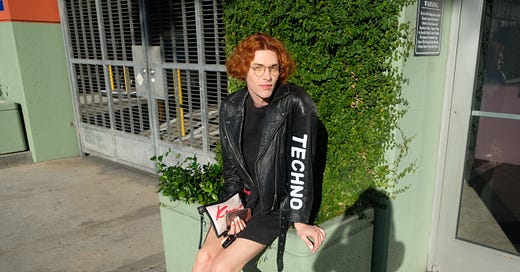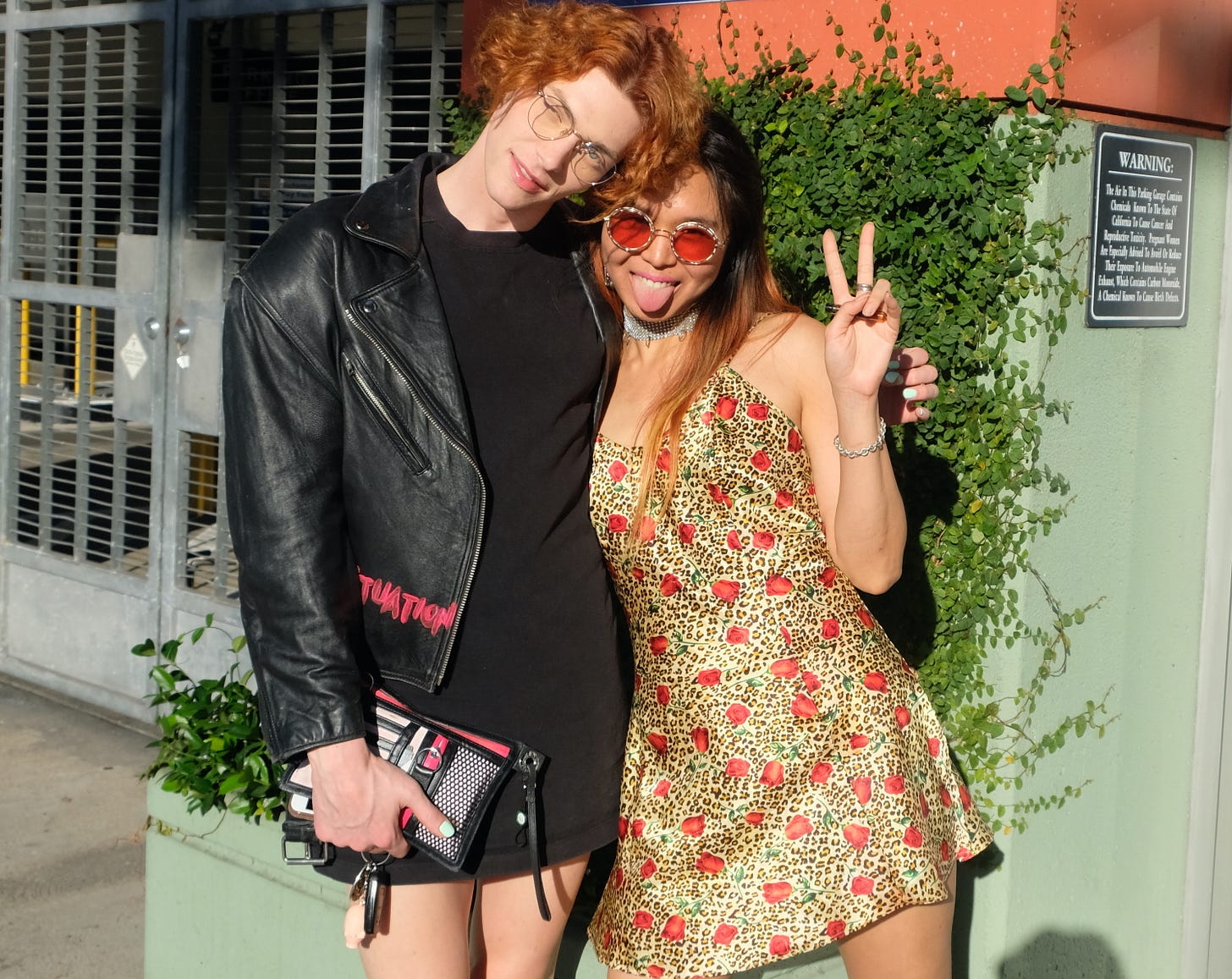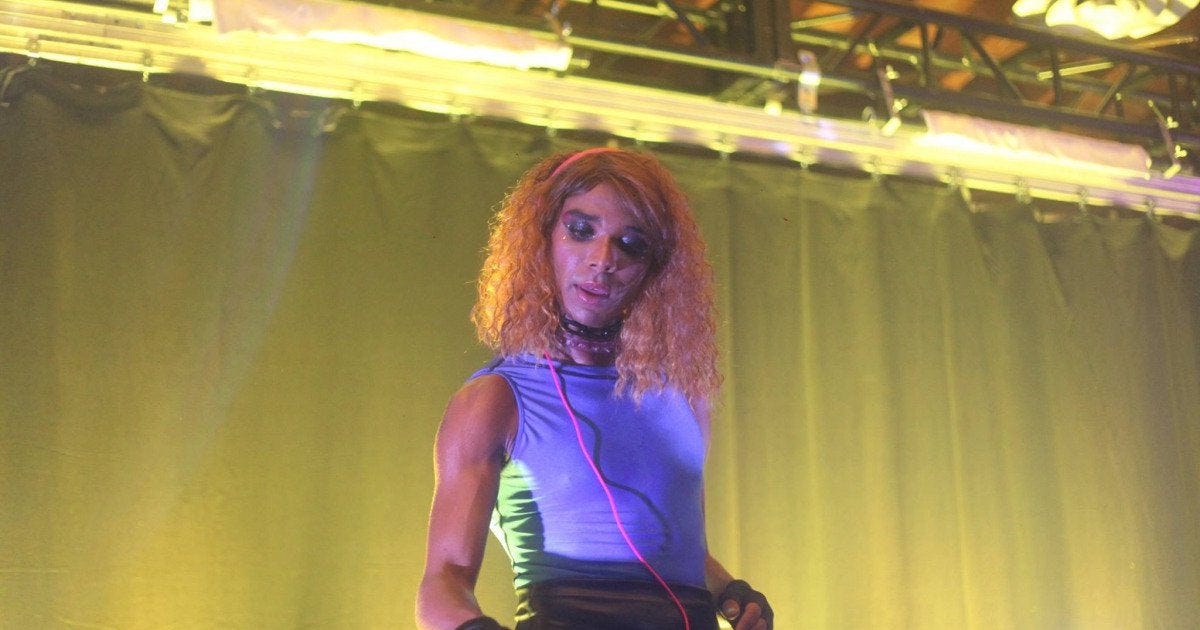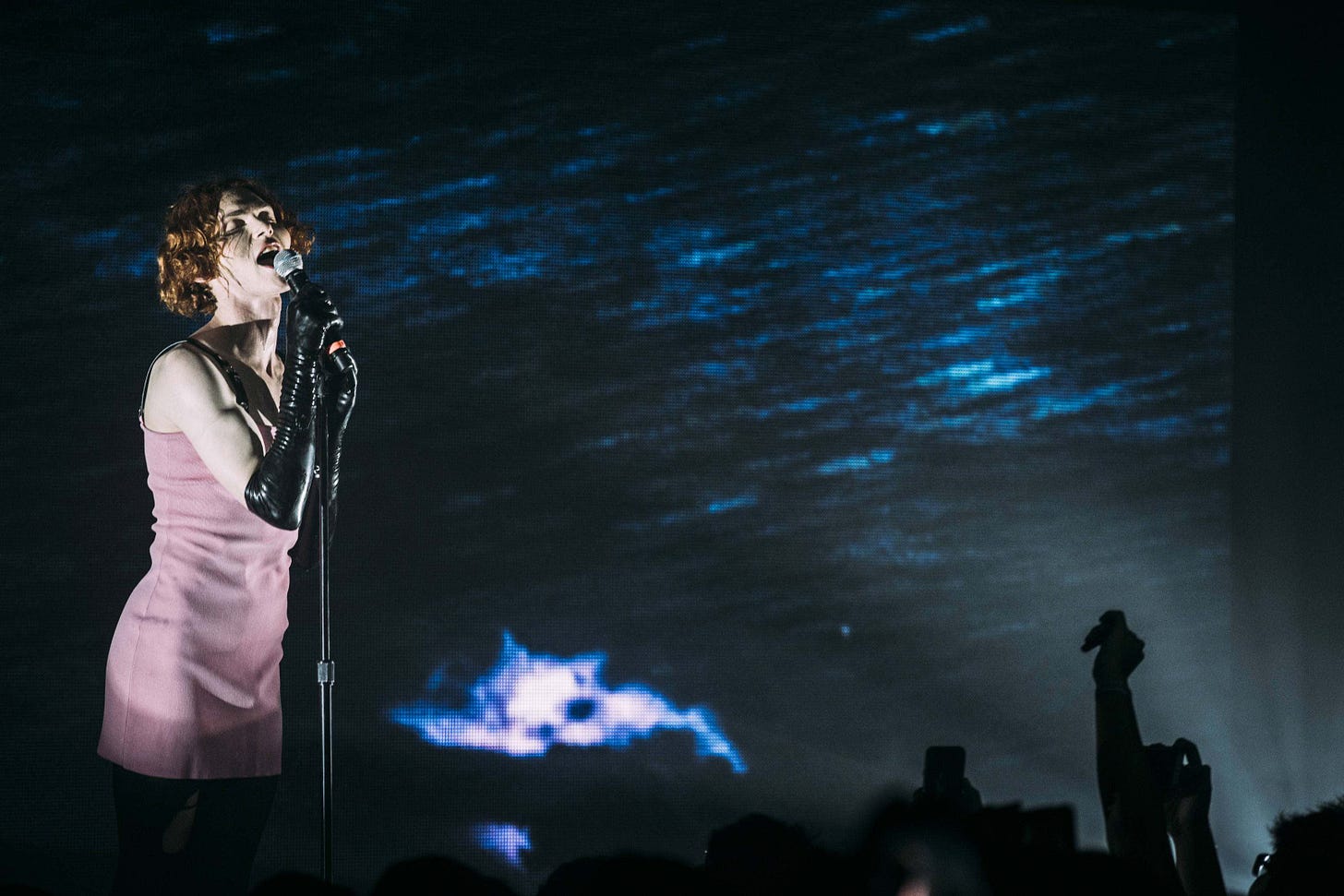WHAT SOPHIE SAID
| RAVES | A never-published interview in honor of our generation's greatest galaxy brain
Sophie in Hollywood in 2017
Grief finally hit like a cloud cracking open after Sophie came to me in a dream. Just off the periphery of my vision so I couldn’t see her expression, just standing there looking effortlessly chic as I cried and cried and cried. It was like the dream lasted all night, just me weeping and her watching—placid, unreadable, silent. When I woke the cold armor of denial I’ve been hiding under had lifted, and I knew the only way out of this thick fog of sadness was to hear her voice one last time, and unbury what she had left me with.
Sophie and I met in 2017 at her favorite diner in Hollywood. She had just released “It’s Okay to Cry” and was just emerging from the veil of anonymity that cloaked her earlier work. Her first interview after transitioning, this felt like a Moment. We slid into a corner booth as TLC and Ashanti jingled through the speakers; she was wearing a leather jacket with TECHNO painted on a sleeve. Outside the glass windows, honking cars choked the golden streets and tourists strolled by seedy porn theaters.
Under a cloud of vape smoke, our conversation flitted between the recurring themes encoded into her music—breaking the binary between the authentic/artificial, playing with the physics/textures of sounds, distilling emotions to their most precise forms. We also chatted about her upcoming live show and partying in LA, where she had been holed up producing for Rihanna and other pop gods. What stuck with me was her quiet dignity and zen-like sweetness—the way she made sure I had enough to eat, held each question like a precious stone, and only gestured subtly to the pain she carried from the mean-spirited criticism and transmisogynistic comments constantly volleyed her way. Sophie lived by embodying her truth rather than explaining it; she showed me how to move through a world that misunderstands your genius, with grace.
Infamous for giving precious few interviews, Sophie only chose to speak when she felt like it, every word precise with intention. Yet she was never cagey or calculated—her aesthetic was synthetic yet honesty was her default mode. Our interview lasted more than two hours, and only a sliver of it ended up in the story for Teen Vogue. ]
So today I’m publishing the full unedited transcript, with the hope that her wells of wisdom can help carry us through this incomprehensible loss. In particular, I am holding on to what she said towards the bottom of this page, about the journey of releasing emotion through time, and there being motion in releasing feelings. If death is a final exhale, Sophie synthesized that sigh into song.
In a year of so much undue suffering it seems so cruel that the greatest musical mind of our generation could be wrenched from us without warning—at the very moment of a radical shift into a Whole New World she was poised to lead us into. What we are left with is this glistening music of joyous, transhumanist hope, and the message from the future she was carrying all along.
Sophie: What would you like to eat? Have whatever you like. You go crazy.
Michelle: [laughs] Oh, I will! So how are you liking LA?
S: I love it. It suits the way I like to operate in my life, which is very studio and work-focused. It’s easy to move around, not pushing through traffic or people too much. Just being able to live a quiet kind of existence here, it really appeals to me. It’s an amazing place to hide if you want to be undisturbed. I don’t feel the same pressure as I do in London to go out every single night.
M: It’s harder to meet qts though.
S: Well what kinds of qts are you looking for?
M: All kinds, I don’t know!
S: Right. I can’t deal with that though. A lot of friends of mine have insatiable energy for going out and being at dinner parties and clubs and bars. I can do that a tiny bit, like maybe once a week to have a sociable moment, but I can’t do that all the time. So LA suits the way I like to live.
M: Do you feel like your sociable-ness comes through your work and collaborations?
S: Yes, it’s more like talking in bars and things that I can’t handle. Which means I’m not suited to New York at all. Also, that’s so cool that you’re friends with Sigrid and Monica [from dance duo FlucT], I adore them.
M: Yes! I actually wanted to ask how working with them in your live show plays into ideas of exploring bodies through electronics and space.
S: Sometimes I would go for a conceptual explanation, but it’s really their atmosphere as people that I really relate to. It just feels empowering to be on stage next to them. I’m trying not to talk about the show too much before it happens because I don’t want to spoil it, but maybe we’ll talk again after? And—thank you for taking the time.
M: Of course, I’ve been following your work for a while.
S: I’ve been reading your articles too, and I really appreciate your perspectives and your support.
M: Ahh, really? It’s cool to be able to speak with you about what your works means, because for so long everyone has been guessing what this means, and to actually hear your intentions being added to that conversation…
S: I’m really interested in making my intentions very clear. Because of the way things have been presented and the things I’m not willing to do to interact with a traditional music journalism context or whatever, there’s been a lot of room for people to fill in the gaps. I think my intentions have been very clear, just misinterpreted really.
M: You’re not interested in anonymity.
S: No, not at all. I’m not interested in the idea of anonymity. I’m interested in the content I put in the work. A lot of artists are more interested in their work than in presenting stories or interacting with the press outside of their music, and that leaves people with the feeling that this person is being anonymous. But it’s really that people like Aphex Twin or Autechre or Kraftwerk I suppose, were withdrawn. A lot of pop producers that I’m lucky enough to work with, it’s really just that they’re very engaged with their work, and the rest doesn’t seem as essential.
When I started to do music, the advice I got from everyone was that you’ve got to be on Facebook, you’ve got to be posting and everything, or nothing is going to happen for you. I was like, but I don’t want to do that. I know what my work is about and I just want to do that and put it into the world. I don’t see why I should interact with these industry standards if it’s not really the thing I’m consuming myself with. But yeah, it was not the intention to be anonymous.
M: It’s almost Warholian, the way you’ve used stand-ins for your shows. The artist in the age of mechanical reproduction kind of thing.
Drag performer Ben Woozy standing in for Sophie at her 2014 Boiler Room set
S: I think there are deeper reasons for that as well. The way I’ve approached all those things is going about things the way that feels good to me, until I feel like I want to change something else. I go with my feelings about what feels good, and what feels honest for me to do. If I go on Facebook and do all these interviews and things, it wouldn’t have felt honest. In the same way that this feels honest for me now, I feel like doing this now.
M: There’s this false binary where people think if you’re directly communicating with your own identity, it’s more authentic than if you’re using a false identity or pseudonym. None of these things have to be authentic than the other.
S: Definitely not.
M: There’s also a performance when you’re presenting as yourself.
S: Absolutely. It’s something that I try to highlight and draw attention to, and it seems to be a recurring theme in the new music as well: questioning what’s real and authentic and artificial. There’s a lot of misconceptions about what that is for people. For sure it’s like a long-haul approach. It’s not an easy way to go about things. But as I said, I feel pretty good saying that everything I’ve done is authentic to who I am, what my interests and perspectives are, what my world views are. These are real questions in this time that we’re living in: how you in some ways might develop an online avatar that is authentically to you, a different side perhaps, or perhaps it’s not you. But those lines are all blurring, and to just acknowledge that’s the case is important, and raise those questions and be transparent about those interactions. Ugh sorry I keep smoking this Juul. I’ve gotten so addicted to it.
M: [laughs] what flavor is it?
S: It’s mango today, what a treat, I’m trying to be good to myself this week. This is so much better you know, for working. When you’re collaborating with people I feel awful if I’m smelling of smoke. I like to create a nice atmosphere for people when I’m working with them.
M: I just wish there was an app called Find My Juul. It’s like a fucking crisis everytime someone loses their Juul.
S: That’s gonna blow my friends’ minds when I get home and tell them that idea. I drive my friends and collaborators crazy—the case of the missing Juuls. Well if you’re around on Saturday there’s a party that I’m DJing at.
M: I’d love to! Where is it?
S: It’s that brand Eckhaus Latta, their Halloween party. Then my friend is DJing this party Lights Down Low.
M: Wait my friend Volvox is coming into town and playing that party too!
S: Yeah it’s going to be fun running around and going to all those things.
M: LA parties are insane. I’ve been invited to ambient noise techno parties in the forest…
S: Oh really? I’ve never been invited.
M: Just like, random people on Twitter sending me a map with directions to the highway. It’s very 90s.
S: Yeah very 90s English vibe, interesting.
M: And these brands throwing weed parties in the Hollywood Hills mansions… I remember walking on acid into my first one and it was just babes rolling unlimited joints and handing them out, I was like this is heaven! I feel like club culture here isn’t as strong because of this 2am curfew bullshit and everything is so sprawled out. So the best parties are happening in the forest or behind closed doors.
S: Hah, you seem to be having a good time here. It’s mainly just house parties and parties at studios that I’m aware of. And parties at my house.
Sophie performing in LA a week after this interview
M: Let’s talk about your new live show. Why was it important to present the music in this context instead of releasing the album first? Why did you want everyone to come in and everything is completely new?
S: Experiencing a more complete vision, a feeling of it. Having it loud and having the ability to use these other tools. All the ideas we had as a team, it was a show that was more than just music. To have the full effect of the ideas, interpreted through these different mediums, presented as one single experience, I think that’s the way I wanted people to experience it initially.
M: I was talking to Kode9 the other day and he was saying that he is only debuting his music in a live show right now because he doesn’t feel the need to release an album, because if all the money and the focus is entirely on the show, why not just do the show?
S: I love that. I’m also interested in communicating through the music video format, having something people can experience on their iPhones whenever they want, on demand. But I love the idea of going to a show and knowing that you’re going to hear something new. Which is why I’ve only ever played my new music in live shows, and played my own music rather than them DJing. Because I think you’re getting a special experience that’s specific to that moment in time. That’s what I would love as an audience member. It can be special.
M: What was the thought process behind the music video? I was reading the Reddit comments and there were some interesting comparisons people were making.
S: And some disgusting ones.
M: Oh yeah, I know. But in general, people are responding to this very emotionally and authentically. There was more snark in the past. And now people are like, omg I’m in love.
S: There is a lot of love. And that word keeps coming up and it makes me so happy. Because I’ve really just felt so much love from people. It’s really interesting when you put something out into the world with love and you’re aware of your intentions and you really have no expectations. You just do something that you feel is right and you feel good in, and you know you’ve been authentic in. And without expectation of it happening, people can receive and understand that, and in return show you some love and support. It’s been overwhelmingly positively received. That’s just an amazing thing to experience, and I feel like being able to communicate that through music gives me a lot of faith in the potential of music.
M: When you wrote the song “It’s Okay to Cry,” who is the “I” and “you” that you’re addressing? Sometimes it feels like you’re singing to yourself?
S: Hm. That’s a good observation. There were three understandings of who was being addressed. And I was thinking about that in the choreography I developed with my friend Todd, kind of breaking it down into sections and thinking about the different tenses and who is being addressed and what I’m feeling internally at those points. One was certainly myself, people at large, and something personal that I’m addressing.
M: Some of it seems very personal: “I walk into the room I saw you reading a magazine.”
S: Yes, it was. I was recalling certain feelings that I had that have stuck with me. But then even though a song might start out as a specific situation that you’re recalling, the ones that stay with you actually take on a less specific and more general meaning, which is actually the theme, and you’ve just been able to access that theme through something personal. If you see what I’m mean, or am I difficult to follow? So ultimately, the song communicates itself pretty clearly: the themes are emotional repression and that kind of thing. The story isn’t important and it can actually be limiting to further explain that situation. It’s more that you’re able to access the root issue and why you felt that feeling in the first place. The title of the song sums up essentially what it’s about. I don’t really feel the need to further explain the context of it.
M: I noticed a lot of your songs are written in a hypothetical or imaginary manner, like “if that’s what you wanna do,” “it’s like we never said goodbye.” But “it’s okay to cry” is much more direct—that’s a statement.
I suppose that’s the way I talk in life. The consistency that you’ve pointed out there is more reflective of the way I want to… it’s raising more questions. Like I said in that Interview piece, music gives you the ability to express something more nuanced and contradictory. It does seem more direct. But going back to what I was saying, it just felt important at that time that I felt like doing that. I don’t know if I can really go further than saying that was my feeling that it was important. What was inside of me, that’s what came out.
M: I guess I’m trying to trace any kind of evolution in the way you think about your music. You said the thing you’re trying to do with pop music is make the brightest and most engaging thing, and it’s not about who can be the most raw emotionally. But that feels different from what’s happening now.
S: What I’m saying is emoting through technology can be equally emotional. Even if you’re not literally talking about crying or being sad or about love. As you know, electronic music can be also very emotional. I suppose I don’t feel that emotion is limited to ballad type song, and songs that I’ve done like “Lemonade,” I think you can be just as raw emotionally through something that seems superficial and light to other people, or purely an exercise in sound design and technology. Communicating boldly, ultimately.
M: Speaking of sound design, how does your interest in motion and moving through electronics affect the way you create sounds? I think I saw somewhere that you’re experimenting with waveforms or something?
S: Yeah, that’s my process. Instead of using samples like the majority of producers, I try to think about the physics of sounds and re-synthesize an impressionistic version of what those sounds are. That comes from my interest in sculpture and materials. It’s a more sculptural approach rather than a painterly approach. Producers who work with samples, it’s more of a collaging approach with making music.
M: What’s the sound that starts off “It’s Okay to Cry”? It’s almost like an inhalation?
S: I was thinking about inhaling and exhaling and Doppler motion effects. That sound is the combination of those two sound ideas. An inhale and exhale has a certain shape and frequencies to it, that we can simulate the effect of. And Doppler also has a particular shape of its pitch envelope that happens when something is accelerating towards you. Ultimately, it’s like, thinking about emotion through time and there being motion in releasing feelings. Ultimately there is the texture of the song. It’s about time passing, and an emotional journey is how you could synthesize those things.
M: Wow you’re like low-key blowing my mind. Releasing emotions through time, synthesized into the Doppler sound of an exhalation.
S: What happens in the video, it can feel like you have all this pent-up energy and you let it all out and you explode out of it. It’s like exploding through time. A combination of those two textures really sum up the ideas of the song.
This is part one of the unpublished Teen Vogue interview. More to come soon.







So precious! Thank you.
great read! thank you for sharing <3